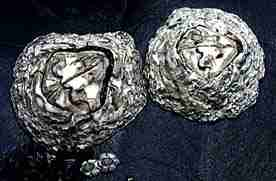|
|
Surf Barnacle Catomerus polymerus
Form:
 The
Surf Barnacle is a distinctively flattened barnacle with eight main shell
plates, surrounded by many smaller plates, becoming smaller towards
the lower edge. Even in eroded specimens the outer plates are still distinctive.
The
Surf Barnacle is a distinctively flattened barnacle with eight main shell
plates, surrounded by many smaller plates, becoming smaller towards
the lower edge. Even in eroded specimens the outer plates are still distinctive.
Colour:
The exterior colour of the Surf Barnacle is grey-white with a greenish tinge.
Phylum: |
Arthropoda |
Author: |
Darwin, 1854 |
Family: |
Catophragmidae |
Size: |
25-30 mm diam: 20 mm height |
Distribution:
 It
ranges from mid New South Wales south around southern Australia to Western
Australia.
It
ranges from mid New South Wales south around southern Australia to Western
Australia.
Habitat:
It occurs on most exposed rocky ocean shores exposed to high energy waves, at mid to low-tide levels. It prefers heavy wave action and spray. On some vertical rock faces it may be found in large numbers.
Biology:
The Surf Barnacle is normally found just above the Galeolaria tube worm zone.
Questions:
Why is this called the Surf Barnacle ?
Why does this barnacle prefer to live in areas with heavy wave action ?
References:
Bennett, I. (1987) W.J. Dakin's classic study: Australian Seashores. p.246, Angus & Robertson, Sydney.
Davey, K. (1998) A Photographic Guide to Seashore Life of Australia. p.40, New Holland, Sydney.
Edgar, G.J. (1997) Australian Marine Life: the plants and animals of temperate waters. p.172, Reed Books, Kew.
Quinn, G.P., Wescott, G.C. & Synnot, R.N. (1992) Life on the Rocky Shores of South-Eastern Australia: an illustrated field guide. p. 61, Victorian National Parks Association, Melbourne.
Marine Research Group of Victoria (1984) Coastal Invertebrates of Victoria: an atlas of selected species. p.104, Museum of Victoria, Melbourne.
Underwood, A.J. ( ) Science Field Guides: Barnacles. p.11, Reed Education, Sydney.
Underwood, A.J. & Chapman, M.G. (1993) Seashores: a beachcomber's guide. p.36, New South Wales University Press, Sydney.
Surf
Barnacle
Six-plated Barnacle
Honeycomb Barnacle
Rose-coloured Barnacle
Rosette Barnacle
Giant Rock Barnacle
Home
Page
Taxonomy
Biogeography
Rocky Shores
Tidal Levels
Intertidal Zonation
Environmental Factors
Biological
Factors
Feeding Relationships
Activities
Glossary
References
 Life
on Australian Seashores
Life
on Australian Seashores
by Keith Davey (C) 2000
Learning Consultant
- Media
The University of Newcastle
email at australian_seashores@hotmail.com
Scientific Consultant: Phil
Colman
site created 01.01.98 : updated 01.04.2000
